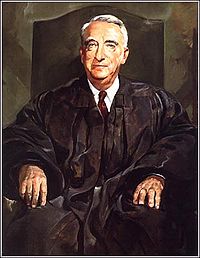Fred Vinson
 From Conservapedia
From Conservapedia | Fred Vinson | |||
|---|---|---|---|
| |||
| Former Chief Justice of the U.S. Supreme Court From: June 21, 1946 – September 8, 1953 | |||
| Nominator | Harry Truman | ||
| Predecessor | Harlan Fiske Stone | ||
| Successor | Earl Warren | ||
| 53rd United States Secretary of the Treasury From: July 23, 1945 – June 23, 1946 | |||
| President | Harry Truman | ||
| Predecessor | Henry Morgenthau, Jr. | ||
| Successor | John W. Snyder | ||
| Former U.S. Representative from Kentucky's 8th Congressional District From: March 4, 1933 – May 27, 1938 | |||
| Predecessor | Ralph Waldo Emerson Gilbert | ||
| Successor | Joe B. Bates | ||
| Former U.S. Representative from Kentucky's 9th Congressional District From: January 24, 1924 – March 3, 1929 March 4, 1931 – March 3, 1933 | |||
| Predecessor | William Jason Fields Elva R. Kendall | ||
| Successor | Elva R. Kendall John Y. Brown, Sr. | ||
| Information | |||
| Party | Democrat | ||
| Spouse(s) | Roberta Dixon | ||
| Religion | Methodist | ||
Frederick Moore Vinson (1890-1953) was the Chief Justice of the United States from 1946 to 1953. Prior to being elevated to the Supreme Court, he served as Secretary of the Treasury (1945-1946), a Judge of the D.C. Circuit Court of Appeals (1937-1943), and was a Congressman for Kentucky in the House of Representatives (1925-1929, 1931-1937).
Career[edit]
Fred Vinson was born in Louisa, Kentucky. He attended Centre College. After receiving his LL.B, he became the City Attorney of Louisa. He was elected District Attorney in 1921, a post he held for three years.
In 1924, he was elected to the House of Representatives as a Democrat. He was reelected in 1926, but lost his seat to a Republican challenger in 1928. However, he was able to reclaim the seat in 1930. Vinson was reelected easily after that. He won choice assignments to the House Appropriations Committee as well as the Ways and Means Committee, where he was able to provide support for the New Deal program of President Franklin Roosevelt.
Roosevelt appointed him to the D.C. Court of Appeals in 1937, leading to his resignation from Congress. In 1943, he resigned his Appellate seat to work for the Roosevelt Administration in several jobs. He was a close personal friend of Harry Truman, who appointed Vinson Secretary of the Treasury in 1945, a post he held for several months.
Chief Justice[edit]
After the death of Chief Justice Harlan Fiske Stone President Harry Truman chose Vinson as his replacement. His Court was noted for hearing a relatively small number of cases per term and initiating the tradition of having clerks write opinions. On September 8, 1953, after seven years as Chief Justice, he passed away and was replaced by Earl Warren.
| The U.S. Supreme Court | ||||
|---|---|---|---|---|
| Chief Justice Fred Vinson's Court (1946–1953) | ||||
|
| |||||
Categories: [United States Supreme Court Justices] [Former United States Representatives] [United States Secretaries of the Treasury] [New Deal] [Anti-Communism]
↧ Download as ZWI file | Last modified: 03/27/2023 14:55:17 | 7 views
☰ Source: https://www.conservapedia.com/Fred_Vinson | License: CC BY-SA 3.0
 ZWI signed:
ZWI signed:
 KSF
KSF